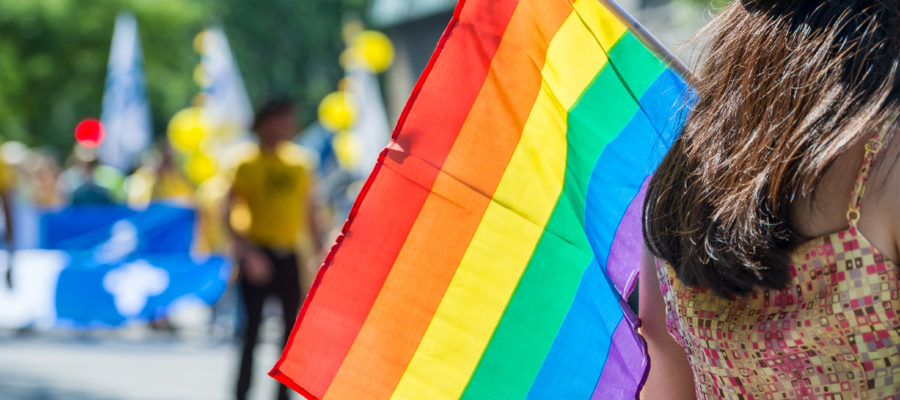Reality Check: Gender Diversity is Driven by a Top-Down Ideological Movement
June 7, 2017 | Published first in MercatorNet
“I never thought this would happen, and certainly not so fast!”
– Larry Ysunza, plaintiff in companion case to the 2015
same-sex marriage case, Obergefell v. Hodges.
No doubt many people around the world feel just like Larry Ysunza—they never thought “this” would happen, and certainly not so fast. Although Larry was celebrating the transformation of marriage through the U.S. Supreme Court’s Obergefell decision in 2015, his words aptly express the grim sentiments felt by many today, the shock of ordinary people who see the gender dominoes tumbling towards the subversion of our most basic human realities: “male” and “female”.
Transgender activists—including now the U.S. Departments of Justice and Education—deny the reality that biological sex is intrinsically connected to male and female identity. But even verbal gymnastics cannot disguise the deep personal confusion that abides within the transgender narrative. A recent NPR story, for example, reported on a study of “transgender men who get pregnant” (biological women who masculinize their bodies and identify as male). The story began by offering the perspective of a 29-year-old transgender “man” who delivered a child: “Pregnancy and childbirth were very male experiences for me…When I birthed my children, I was born into fatherhood.”
Reality? No. Delusional thinking. Reality tells us this person is, and always has been, female; because she is a woman, she was able to conceive and carry a child, to give birth and became a mother—and her feeling-based “male identity” can’t change the reality that she’s a mom, not a dad. Her situation is tragic, and she needs our compassion. It’s a false kindness, however, to affirm her fantasy. And it’s just plain crazy for the government to insist, under penalty of law (e.g., New York City’s gender identity regulations) that the rest of society must jettison the truth and become bit players in the transgender person’s delusional script.
And yet here we are, still fumbling for the simple, clear words (or maybe the courage) to persuade our fellow citizens that it’s not bigotry to insist on the truth—that a woman can’t “be” a man or a father, ever, and that even the strongest feelings and the best surgeons can only mask that reality, not change it. Of course, the same applies to men who want to “be” women; similarly, two men or two women cannot have a marriage, in reality (no matter what human law erroneously decrees), because the truth about marriage is that it occurs only between a man and a woman, Justice Kennedy notwithstanding.
Facing the ideological reality
But maybe our head-shaking dismay—our bewilderment—at the swift collapse of rational discourse about the human person, sexuality, and marriage suggests that we could do with a reality check too. “I never thought this would happen, and certainly not so fast,” we say. So let me ask: why are we so surprised at the ‘transgender moment’? It was—is—utterly predictable, given the ideological reality of the ‘gender agenda,’ its roots, strategies, tactics, and endgame.
And perhaps therein lies the problem: apart from dedicated activists and scattered others, too few in our families, churches, neighborhoods, and even political parties seem to have recognized or responded to the ideological reality driving our cultural disintegration. I know good people who seem to cling to the false hope that our cultural divide is not ideological at all, but a reflection of unfamiliarity, fear, and inadequate compassion. And the movement slogan (“Love wins!”) offers reassurance that the LGBT community merely wants what we want—compassion, tolerance, and respect—because “love is love” and surely we can all get along. It’s understandable why they would hope as much, because the bait dangled before us, early on in the sex and gender campaigns, promised voters that same-sex marriage would not mean schoolchildren would be taught values against their parents’ wishes; and talk about polyamory was labeled a scare tactic to deflect attention from the long-term partnerships of gay men and lesbians. But those were tactics, effective ones. Today, American universities offer crash courses in polyamory and UK students as young as 11 will learn that the only limit to their choice of gender is their “imagination.”
Ideologues don’t want what the rest of us want.
The endgame for gender ideologues and their allies (feminist, Marxist, gay, lesbian, “gender-queer,” and so forth) has nothing to do with bathrooms and everything to do with the things we cherish most: they are bent on dismantling the natural family, marginalizing or muzzling religious belief, particularly Christianity, and exalting personal “will” and autonomy above everything (except the state, of course). And there is no middle ground.
Two days ago, on June 6th, Norway’s parliament approved new health care provisions giving “trans people aged 16 and older” the right to “self-determination.” Thus, teens and adults can declare a gender and have it recognized by the state—no questions asked, no psychological evaluations, no hormones or surgery, and no waiting periods. (The bill requires children through the age of 15 to obtain parental approval.) Victory, right? No, it’s still not enough for trans activists. ILGA- Europe, the voice of over 400 LGBT organizations and allied groups spanning 45 countries, issued a statement supporting Norway, but adding:
[T]here is still work to be done. LGBTI activists in Norway have rightly pointed out that these self-determination reforms do not remove age limits or make any provision for non-binary adults and children. ILGA-Europe will continue to support our members and friends in Norway every step of the way in their fight for full equality.” (Emphasis added).
Norway’s LGBT advocates aim to emancipate children—of any age—from parental control, setting them free to select a gender and declare for themselves ‘who they really are.’ No, half-measures don’t satisfy ideologues.
It’s important, for our own reality check, to realize that the triumph of trans “reality” is neither accidental nor organic. The “equality movement” that forced same-sex ‘marriage’ on all 50 states (with help from the U.S. Supreme Court) did not bubble up spontaneously from the shared concerns of grandmas in Ohio, first-generation Americans in Texas, dads in Nebraska, or moms in South Carolina.
The LGBT movement is a top-down phenomenon
Rather, the LGBT movement is a top-down phenomenon, driven by transnational networks of liberal activists, corporations, governments (particularly the US), international organizations (the UN), and elite donors. This shouldn’t surprise us much. Culture change is typically powered by institutions and elites, observed James Davison Hunter in his book To Change the World—and the transformation of sex and gender norms, and family structure, bears this out.
The U.S. donor community, for example, has invested substantially in LGBT causes. The 2014 Tracking Report on LGBT and Queer Grantmaking reported that, in 2014 alone, private U.S. foundations dispersed over $153 million in LGBT-related grants, nearly half for advocacy. Individual philanthropists contributed millions more. The strategic plan for one donor group, Funders for LGBTQ Issues, calls for foundations to increase their giving to LGBTQ causes to $200 million annually by the year 2017.
It’s worth noting that LGBT donors aren’t spending their philanthropic dollars on building buildings with their names on them or other vanity gestures—they are making social change happen. Food for thought.
The ideologues have global impact too. The Obama Administration and the United Nations have teamed up, and gender ideology is spreading like wildfire across the globe—not only through the open efforts of governments and international organizations but also through the work of local proxies, whose capacity-building, training, and operations benefit from outside funding. The U.S. government has mainstreamed LGBT concerns across multiple domains, creating public-private initiatives like the Global Equity Fund and utilizing the wide reach of U.S. diplomacy and foreign aid. USAID has integrated LGBT concerns into its global development agenda and by 2014 had “conducted LGBT 101 trainings” for “more than 1,000 local staff in more than 30 countries around the world.” Randy Berry, President Obama’s Special Envoy for the Human Rights of LGBTI Persons, traveled to 42 countries his first year on the job, promoting social change and human rights on behalf of LGBTI people. (One Catholic bishop in Africa describes Berry’s work quite differently—as “cultural imperialism.”)
The United Nations too has multiple avenues through which it promotes gender ideology, including the “largely unnoticed…UN LGBT Core Group, a wide network of countries and civil society organizations that aims to ensure a place for ‘SOGI’ (sexual orientation and gender identity) issues on the UN agenda.” Similar efforts take place within the European Union and on other continents.
Increasingly, multinational businesses demonstrate leadership in driving the gender agenda forward. The recent dust-up in North Carolina spurred a number of companies to flex their political muscles, threatening boycotts unless the State of North Carolina withdrew its controversial law restricting bathroom use according to birth sex. But that display of corporate power is the tip of the iceberg. Over the past few years, LGBT advocates have methodically pitched a “business case” for LGBT inclusion to decision-makers at the most influential transnational corporations. And they’ve succeeded in swinging support their way.
In March 2016, the Economist sponsored a global summit, Pride and Prejudice, via simultaneous webcast in Tokyo, London and New York. The featured speakers, top executives from the most influential global businesses, presented the “business case for LGBT diversity and inclusion.” They also hammered home the “economic and human costs” of LGBT discrimination—including the threat of expensive litigation.
In January 2016, LGBT activists were present for the second straight year at the World Economic Forum (“Davos”) and U.S. Vice-President Joe Biden addressed the Davos crowd on behalf of the LGBT agenda. He urged corporations to “lean on” countries that resist Western-style openness to LGBT lifestyles. By pressuring these countries to liberalize their laws, Biden noted, “You [corporations] literally can change the terms of the debate…You can actually put governments on notice.”
Corporations are the government’s new strongmen, and they seem to relish the job.
Religion in the crosshairs
Two other points are important for our reality check. First, people of faith at all points on the political spectrum need to acknowledge that gender ideologues have religion in the crosshairs. The activists and funders who targeted Ireland for LGBT reform more than a decade before the same-sex ‘marriage’ victory in 2015, for example, were openly contemptuous towards Catholicism—and made no secret of their intent to manipulate religion to advance the LGBT agenda:
Organized religion is at the heart of LGBTI oppression and needs to be deconstructed. [But] How can one deconstruct an institution that provides hope and comfort to millions of desperate people? … An engagement needs to come from groups within the churches. They need capacity-building and support…LGBTI organisations need to appropriate Christian values for a progressive rights agenda. (Emphasis added.)
Atlantic Philanthropies 2010 report, “A Meeting of Queer Minds”
And in the recent years, several LGBT donors have embarked on well-funded campaigns that target religion in one of two ways. One effort manipulates religion—attempting to re-shape the beliefs of religious individuals and faith communities to better align with LGBT communities and political objectives. The Arcus Foundation, for example, recently announced that, “grants in Arcus’ spring 2016 portfolio target the religious reasons that underpin so many of the obstacles to LGBT freedom and safety.” Its grant to the Reformation Project aims “to reform church teaching on sexual orientation and gender identity among conservative and evangelical communities.” Yes, you read that right—one of the largest LGBT-focused foundations is funding efforts to help evangelical churches “reform” in ways supportive of the LGBT agenda. (Arcus is also the lead funder behind the $20 million dollar Global Trans Initiative launched in 2015 to promote acceptance, support, and full legal and social “equity” of trans people.) Other LGBT donors have made similar grants aimed at re-shaping faith perspectives.
A second funding trajectory targets “religious exemption” laws. Gender ideologues portray conscience claims as a license to discriminate, a smokescreen for mechanisms that carve out space for bigotry and animus towards non-heterosexuals and gender non-conformists. As Kevin Jones reported in a 2015 investigative piece for the Catholic News Agency, prominent LGBT advocates and grant-makers are spearheading the fight against religious exemptions—and they aim to win within three years. Their funding encompasses not only legal fights, but also communications projects designed to turn public opinion against religious freedom. The Movement Advancement Project, for example, funded by LGBT heavy-hitters, develops policy and messaging guidance for LGBT efforts to fight religious exemptions.
This reality check is necessarily limited, but I’ll close by bringing the focus back around to why this matters—gender ideology is not an abstract debate. It’s about people. If we’re willing to confront gender ideology, then there’s hope that we will stop averting our eyes from another reality, a tragic one—the growing numbers of children and young adults who are terribly confused about sex, gender, and basic identity. The trendy “gender fluid” framing obscures the truth that these are suffering souls. Watch the video linked in this article and imagine an entire generation like this, decimated by a lie that we let take root.
Unless we—individuals, families, churches, schools, businesses, and political parties—counter gender ideology, we will find ourselves in a world we don’t recognize, saying to ourselves once again: “I never thought this would happen, and certainly not so fast!”



